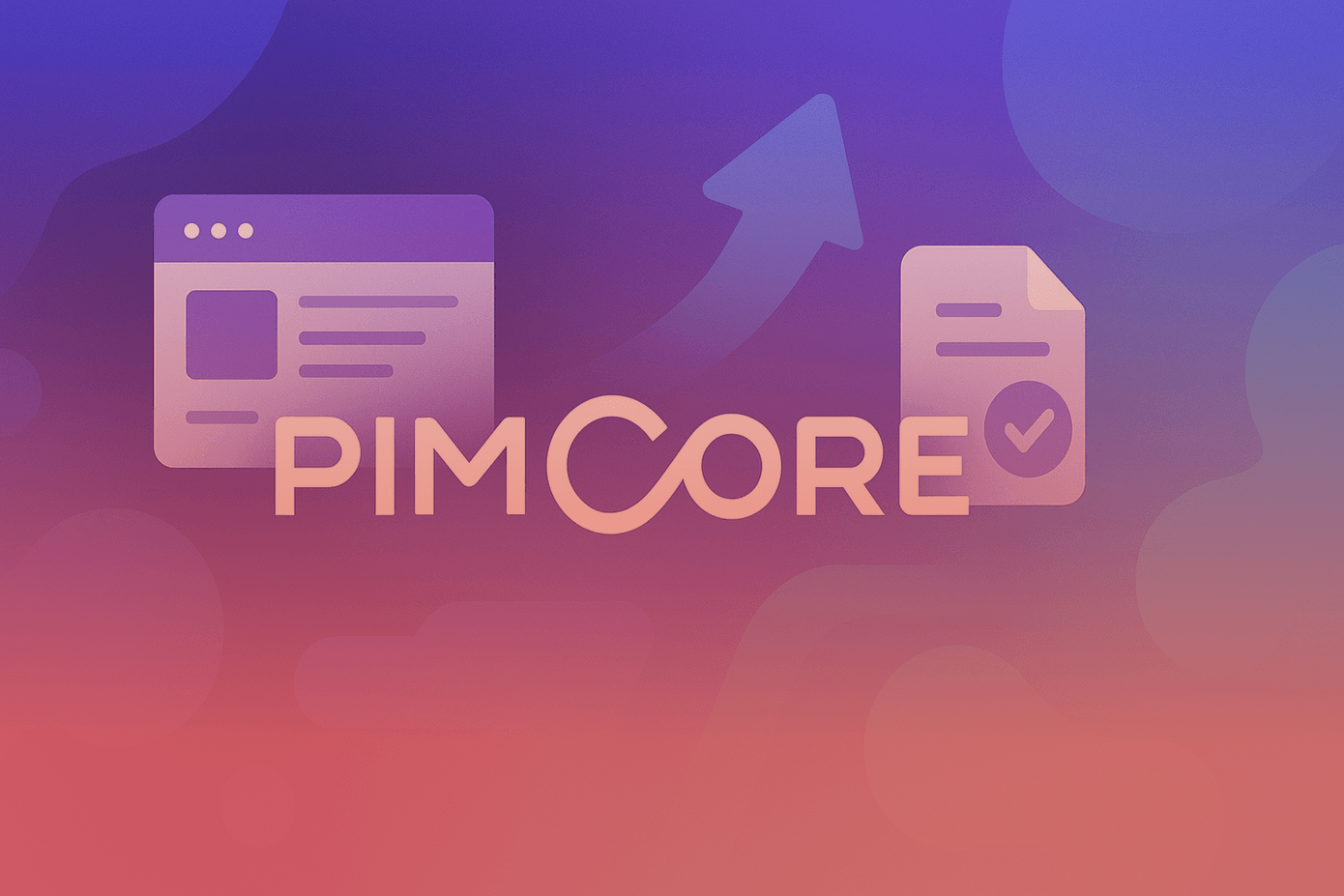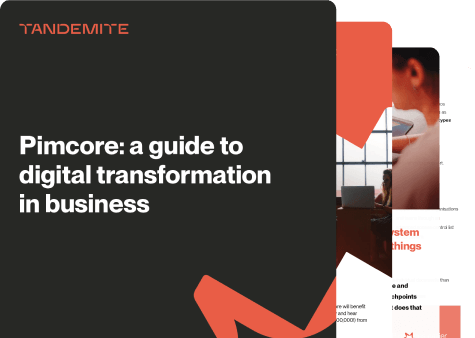We’ve been working with Pimcore for years, and let us tell you: when Pimcore makes a big announcement, we pay attention. On April 29, 2025, Pimcore dropped some major news that every company using the platform needs to know about. They’re rolling out a new user interface and changing the software’s licensing model – big moves that can impact how you use (and pay for) Pimcore.
In this post, we’ll break down exactly what’s changing, why Pimcore is doing it, and what it means for you. By the end, you’ll know the key facts and have a clear idea of how to ride through these changes smoothly.
Key takeaways
✅ Fresh, modern interface: Pimcore introduced a new admin interface called Pimcore Studio to replace the old ExtJS-based UI. It’s designed for greater flexibility, speed, and ease of use – with an intuitive look, customizable workspaces, mobile-friendly design, and faster performance.
✅ License model shake-up: Pimcore is moving its free Community Edition from a GPLv3 license to the new Pimcore Open Core License (POCL). This change is meant to eliminate legal uncertainties of GPLv3 and give companies more flexibility (you can keep your custom Pimcore extensions private without worrying about open-sourcing everything).
✅ Free for small businesses, paid for big players: Under the new license ⬆️, Pimcore remains free for organizations with less than €5 million in annual revenue, as well as non-profits and educational institutions. If your company makes more than €5M and you upgrade to the latest Pimcore version, you’ll be required to get a commercial license to stay compliant.
✅ Upgrade timeline: Support for Pimcore 11 (Community Edition) ends in Autumn 2025, and the old “classic” UI will be phased out by December 2026. In other words, you should plan to upgrade to Pimcore’s 2025 version (a.k.a. Pimcore v12 with the new Studio UI) before then to keep receiving updates and support.
Interface upgrade: The new Pimcore Studio UI
The first big change that was announced during Pimcore Inspire 2025 is a brand-new user interface called Pimcore Studio. If you’ve used Pimcore’s back-end before, you know it’s powerful, but the old interface (built on ExtJS) could feel dated. Pimcore Studio is a complete redesign of the admin experience, built with modern technology (React JavaScript framework and a fresh design system) to make it more user-friendly and flexible. By moving to a contemporary tech stack, Pimcore is ensuring the platform’s frontend doesn’t become a bottleneck for future upgrades and features.
So what can you expect from the new UI? For starters, it’s faster and more intuitive. Pimcore specifically designed Studio to meet today’s business needs: greater flexibility, speed, and ease of use. The interface is clean and modern – even non-technical users will find it easier to navigate. Each user can tailor their workspace to suit their workflow, so you’re not stuck with a one-size-fits-all layout. And because responsiveness is a must-have now, Pimcore Studio works smoothly on your laptop, tablet, or phone without missing a beat. No more pinching and zooming on mobile or dealing with clunky old UI elements.
Performance has also been a key focus. The new interface loads data faster and feels snappier when you click around. If you have a huge product catalog or asset library, this is a welcome improvement.
One question we often hear is, “Do we have to switch to the new UI immediately?” The good news is you can adopt Pimcore Studio at your own pace. The 2025 Pimcore version (v12/2025.1) includes the new Studio UI, but it doesn’t force you to abandon the legacy interface overnight. In fact, you can run the Studio UI alongside the classic UI and toggle between them – which is great for training your team or handling any features that aren’t yet in the new interface. Pimcore expects to have full feature parity by Q4 2025, and by Q1 2026 the Studio will become the default experience. Until then, think of Studio as an opt-in preview of the future that you can try out gradually. Upgrading to the 2025 version (which introduces Studio) sooner rather than later ensures you stay fully supported and secure.
License changes: From GPLv3 to the Pimcore Open Core License (POCL)
The second big announcement is a change in Pimcore’s licensing for the Community Edition. This is a pivotal shift, so let’s unpack it. Historically, Pimcore’s free, open-source Community Edition was released under the GPLv3 license. GPLv3 is a “copyleft” open-source license that requires any modified code or derivative works you distribute to also be open-sourced under GPL. In theory, that protects software freedom. In practice, many companies had issues with GPLv3. Why? The strong copyleft obligations created a lot of legal uncertainty for businesses. Corporate legal teams often see GPL licenses as risky – they worry that using GPLv3 code might force them to expose their own proprietary code, or they spend tons of time and money on license audits to ensure compliance. In some cases, these concerns have slowed down or even blocked projects.
Add to that the evolving regulatory landscape. For example, the EU’s NIS2 directive calls for clearer software supply chain security and governance. Pimcore’s founders recognized that GPLv3, while noble in its intentions, was difficult to align with the compliance standards and legal structures of corporate environments.
Announced in April 2025, Pimcore Open Core License (POCL) is Pimcore’s new licensing model starting with the 2025.1 release (the first version to include the new UI). So, what is POCL exactly? It’s a type of license that keeps Pimcore’s source code open and accessible but introduces some usage conditions to address the aforementioned issues. The Pimcore team calls it “open core,” meaning the core platform is still openly available, but with clear rules to prevent misuse or legal ambiguity.
With POCL, you still have full access to Pimcore’s source code (nothing changes for developers who want to look under the hood or customize the platform). You’re also explicitly allowed to build private, proprietary extensions or plugins on top of Pimcore without having to share that code publicly. In short, POCL protects Pimcore’s open nature while removing the strings that made some lawyers nervous. It’s about open development with business-friendly clarity.
However, POCL does come with a few new rules, mainly around how Pimcore can be used and who might need to pay for it. One notable restriction (likely irrelevant for most end-users, but worth mentioning) is that you can’t take Pimcore’s Community Edition and offer it as a SaaS product to others without a special OEM license – Pimcore wants to avoid someone else repackaging their platform as a cloud service. They’ve also put in place safeguards to prevent mixing POCL code with GPLv3 code in the same application environment (to avoid license conflicts). The headline change for most organizations, though, is the introduction of a revenue-based usage threshold under POCL.
Who needs a commercial license now?
Let’s get to the crux of it: will your company have to start paying for Pimcore? The answer depends on your situation. Pimcore’s new license policy is targeted at larger businesses using the free Community Edition. According to the announcement, the license changes apply if you use the Community Edition, upgrade to the new version (v12/2025+), and your organization generates more than €5 million in annual revenue.
If all three conditions are true, then yes, you’ll be required to purchase a commercial Pimcore license going forward.
In practical terms, that means big companies who have been running Pimcore for free will need to budget for a license once they move to the 2025.1 version or later. Pimcore offers paid editions like the Professional Edition (and Enterprise Edition), which come with additional benefits and support.
Now, if you’re a smaller business or non-profit, you can breathe easy: Pimcore remains free for you. The rule is clear that if you’re under the €5M revenue threshold, or you’re an educational institution or charity, you can continue using the Community Edition without paying license fees. Pimcore explicitly says it “will remain free” for these categories. It’s a move to ensure the sustainability of the platform (larger enterprises contribute financially) while keeping it accessible to startups, small companies, and public-good projects.
What if you’re already a paying Pimcore customer? Then nothing changes for you on the licensing front. Companies using the Professional, Enterprise, or PaaS (cloud) editions are already compliant and have their licenses. The new POCL rules mainly affect the Community Edition. So, for example, if you’re on Pimcore Enterprise Edition because you needed enterprise support or features, you’ll just continue with that as usual (and you also get the new UI and all improvements as part of your subscription, of course).
One more thing to note: Pimcore has indicated they reserve the right to audit companies’ financials if needed, to enforce the new license terms.
Why upgrading to Pimcore 2025+ is critical (benefits and risks)
With a new UI and a new license model on the table, you might wonder, “What if we just stick with our current Pimcore version and ignore these changes for a while?” It’s a valid question. Upgrading a core system isn’t trivial – it requires planning, testing, maybe some refactoring.
Let’s break down the benefits of upgrading versus the risks of staying put.
First, the benefits of upgrading to Pimcore v12 (2025.1):
- Stay modern and supported: You get the shiny new Studio UI and all the productivity enhancements that come with it, and you ensure your platform is on a supported version. Being on a supported version means you’ll continue receiving security patches, bug fixes, and improvements regularly.
New features and improvements: The latest version brings other improvements too – for instance, upgraded reporting and analytics tools, better overall performance, and compatibility with newer technology standards. It’s not just a UI swap; it’s an overall evolution of the platform with features that can empower your team. - Easier compliance: With POCL, using Pimcore is more straightforward from a legal standpoint. If your company needs to meet software governance or security requirements (say, to satisfy internal policies or laws like NIS2), the new version helps you do that with less friction.
Now, the risks if you don’t upgrade in time:
- No more support: After autumn 2025, Pimcore will no longer officially support Community Edition v11. That means no more bug fixes or help from the vendor (and even community attention will shift to newer versions). If something breaks, you’re on your own.
- Outdated technology: Pimcore 11 is built on older tech (the legacy ExtJS UI and an older PHP/Symfony stack). Without updates, those underlying technologies will become increasingly outdated and vulnerable. Integrations with other systems might start failing as things evolve around an old core.
- Security vulnerabilities: Running an unsupported Pimcore means missing future security patches. Over time, that leaves your data and system open to known exploits. No business wants to be stuck on a platform with a security hole simply because it didn’t upgrade.
- Bigger upgrade headaches later: The longer you wait, the more complicated (and expensive) it could be to update down the road. Skipping one version is manageable; skipping several years of changes can turn an upgrade into a major project, since you might need to overhaul custom code that’s now far out-of-date.
Have questions about how these changes affect your specific use case? If you’re feeling uncertain about the next steps – whether it’s planning a version upgrade, evaluating Community vs. Enterprise edition, or ensuring your custom integrations will still work – we’re happy to chat and figure out the best path forward for your organization.
The key is to plan ahead: budget for the license if you need one, schedule the upgrade when it causes minimal disruption, and train your team on the new interface.
Get in touch with our team at Tandemite. As Pimcore solution experts, we’ve been following these developments closely. We’re helping clients big and small navigate the shift.







